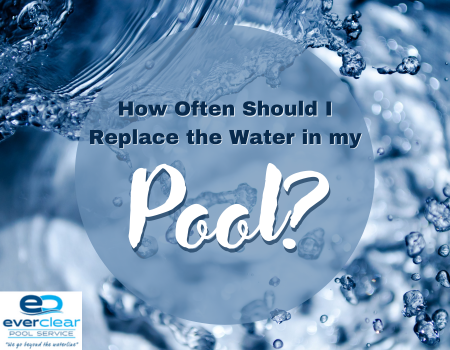Wondering if it’s time to replace the water in your pool? Maintaining a sparkling, inviting pool involves more than routine cleaning and chemical balancing; it also entails addressing the water itself. Many pool owners often wonder, “How frequently should I change my pool water?” This article delves into the factors influencing the necessity of replacing pool water and provides guidance to guarantee that your aquatic sanctuary stays a clean and pleasurable escape.
How Often Should You Replace the Water in Your Pool?
 Water Chemistry and Balance:
Water Chemistry and Balance:
The chemical composition of pool water plays a crucial role in its overall quality. Over time, the accumulation of minerals, dissolved solids, and other contaminants can impact water balance. Regular monitoring of pH levels, alkalinity, and calcium hardness is essential. When these levels become challenging to maintain within the recommended range, it might be an indicator that water replacement is necessary.
- Total Dissolved Solids (TDS) Levels:
Total Dissolved Solids represent the cumulative concentration of minerals, salts, and organic matter in pool water. As water evaporates, these solids remain behind, leading to an increase in TDS levels. While a certain level of TDS is expected, elevated concentrations can affect water quality and clarity. If TDS levels become too high, dilution through water replacement may be recommended.
- Cyanuric Acid Levels:
Cyanuric acid, commonly known as stabilizer or conditioner, is essential for protecting chlorine from degradation due to sunlight. However, excessive cyanuric acid levels can hinder the effectiveness of chlorine. If cyanuric acid accumulates beyond the recommended range, diluting the water through partial replacement becomes a solution.
- Calcium Hardness:
Calcium hardness refers to the concentration of calcium ions in pool water. Low calcium hardness can lead to water becoming corrosive, potentially damaging pool surfaces and equipment. Conversely, high levels can result in scale formation. Regular testing and adjusting of calcium hardness levels can prevent these issues and extend the lifespan of pool components.
- Water Clarity and Aesthetic Concerns:
The visual appearance of pool water is a key factor in determining the need for replacement. If the water appears cloudy despite proper chemical balancing and filtration, it may indicate the presence of impurities that necessitate dilution through water replacement. Murky or discolored water is often a sign that the pool water has reached its limit in terms of cleanliness.
Guidelines to Replace the Water in Your Pool:
- Regular Monitoring:
- Implement a routine water testing schedule to assess chemical levels, TDS, and other factors influencing water quality.
- Regular monitoring allows for proactive adjustments and helps identify when water replacement is needed.
- TDS Levels:
- While there is no fixed TDS level that mandates water replacement, many experts suggest considering partial water replacement when TDS exceeds 1,500–2,000 parts per million (ppm).
- Regularly testing and tracking TDS levels can guide decisions regarding the frequency of water replacement.
- Calcium Hardness:
- Maintain calcium hardness within the recommended range, typically 200–400 ppm for most pools.
- If levels are consistently outside this range, partial it might be time to replace the water in your pool partially.
- Cyanuric Acid:
- Keep cyanuric acid levels within the recommended range of 30–50 ppm.
- When levels exceed 100 ppm or become challenging to manage, partial water replacement can help restore balance.
- Visual Assessment:
- Trust your instincts and visually assess the clarity and appearance of the water regularly.
- If the water appears consistently cloudy or discolored, despite proper maintenance efforts, it may be time for to partially replace the water in your pool.
The frequency of pool water replacement depends on a combination of factors, including chemical balance, TDS levels, and visual clarity. Regular testing and monitoring, along with proactive adjustments, are essential components of effective pool maintenance. While there is no strict timetable for water replacement, the key is to be attentive to the changing conditions of your pool and take action when necessary. With conscientious care, your pool can remain a refreshing haven for relaxation and enjoyment.
